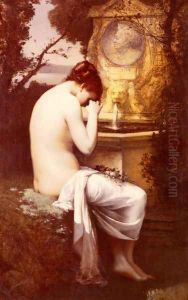Joseph Nicolas Hippolyte Aussandon Paintings
Joseph Nicolas Hippolyte Aussandon was a French artist born in 1812, in a period that witnessed the aftermath of the Napoleonic Wars and the restoration of the Bourbon monarchy. Not much is known about his early life, but it can be assumed that he received his artistic training during a time of significant political and social upheaval in France. This era was marked by a return to classical order and discipline in the arts, following the excesses associated with the Empire style under Napoleon. However, as Aussandon's career progressed, he would have experienced the rise of Romanticism, a movement that emphasized emotion, individualism, and the sublime beauty found in nature and exotic locales.
Aussandon's work is not widely documented, and he remains a relatively obscure figure in the pantheon of 19th-century French artists. Nevertheless, he contributed to the rich tapestry of French art during a period that was incredibly dynamic, both politically and culturally. His artistic output would have been influenced by the major movements of his time, from Neoclassicism to Romanticism, and possibly even the early inklings of Realism, which began to take root towards the latter part of his career.
Over the course of his life, the political landscape of France underwent dramatic changes, from the restoration of the monarchy to the revolutionary upheavals of 1848, and eventually, the establishment of the Second Empire under Napoleon III. These events would have provided a backdrop of constant change and uncertainty that shaped the cultural output of the era, including Aussandon's work. Despite the lack of specific details about his oeuvre, it is likely that his art reflected the tensions and transitions of his time, capturing the complexities of French society as it struggled to find its identity between tradition and modernity.
Joseph Nicolas Hippolyte Aussandon passed away in 1887, having lived through some of the most turbulent and transformative decades in French history. His legacy, though not as celebrated as that of his contemporaries, offers a glimpse into the diverse and evolving landscape of 19th-century French art. Through his contributions, Aussandon played a part in the intricate story of a nation's cultural and artistic journey during a century of profound change.
